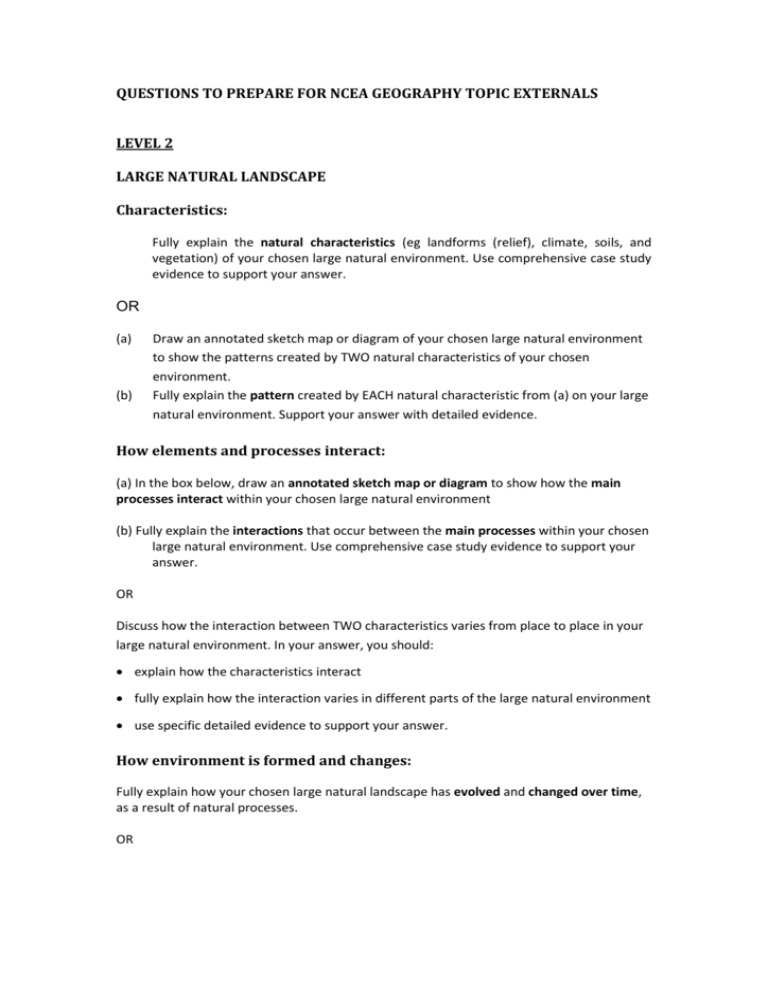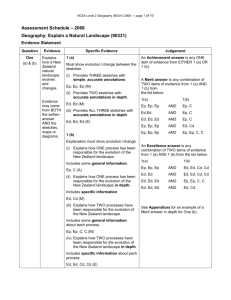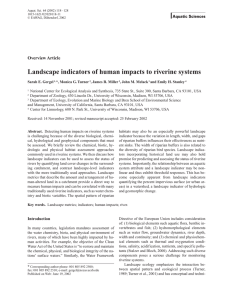QUESTIONS TO PREPARE FOR L2 NCEA GEOGRAPHY TOPIC
advertisement

QUESTIONS TO PREPARE FOR NCEA GEOGRAPHY TOPIC EXTERNALS LEVEL 2 LARGE NATURAL LANDSCAPE Characteristics: Fully explain the natural characteristics (eg landforms (relief), climate, soils, and vegetation) of your chosen large natural environment. Use comprehensive case study evidence to support your answer. OR (a) (b) Draw an annotated sketch map or diagram of your chosen large natural environment to show the patterns created by TWO natural characteristics of your chosen environment. Fully explain the pattern created by EACH natural characteristic from (a) on your large natural environment. Support your answer with detailed evidence. How elements and processes interact: (a) In the box below, draw an annotated sketch map or diagram to show how the main processes interact within your chosen large natural environment (b) Fully explain the interactions that occur between the main processes within your chosen large natural environment. Use comprehensive case study evidence to support your answer. OR Discuss how the interaction between TWO characteristics varies from place to place in your large natural environment. In your answer, you should: explain how the characteristics interact fully explain how the interaction varies in different parts of the large natural environment use specific detailed evidence to support your answer. How environment is formed and changes: Fully explain how your chosen large natural landscape has evolved and changed over time, as a result of natural processes. OR (a) Draw annotated sketches, maps and / or diagrams to show THREE significant stages in the formation/evolution of your chosen large natural landscape through time. Give each stage a title. (b) Fully Explain how your continental natural landscape has changed over time. How people interact: Fully Explain how TWO different human activities have affected your chosen large natural landscape. Use specific information about your landscape, which should include labelled sketches, maps, or diagrams. OR Fully Explain how one CULTURAL and one ECONOMIC interaction by people has affected your chosen large natural landscape. Use specific information about your landscape, which should include labelled sketches, maps, or diagrams. How people’s perceptions change over time: (a) Draw an annotated diagram to show how one group or individual’s perception of your chosen large natural environment has changed over time. (b) Fully explain how this group or individual’s perception of your chosen large natural environment has changed over time. Use comprehensive case study evidence to support your answer. DIFFERENCES IN DEVELOPMENT Characteristics of Development: (a) Choose TWO characteristics of development from the list below. health (eg, infant mortality rates) education (eg, literacy rates) employment (eg, ethnic unemployment rates) population growth (eg, GNP/capita) social (eg, racial discrimination) political (eg, voting rights). (b) Fully explain how EACH characteristic clearly demonstrates the differences in development between communities, areas, or countries across the globe that you have studied. You must support you answer with detailed evidence. How development is measured: (a) GDP is widely used to compare levels of development between communities, areas, or countries. Fully explain the limitations of using this indicator to measure levels of development. (b) In 1990, a new indicator was developed called the Human Development Index (HDI). Fully explain why the HDI is used as an indicator of levels of development. OR Fully explain what problems are associated with using various qualitative and quantitative indicators as measures of development. Use specific information from your case study country or countries. OR (a) Identify TWO indicators that you have selected as good indicators in measuring development in your named case study countries or regions. (b) Fully explain why you consider these to be suitable to measure development in your case study countries or regions. Factors contributing to differences in development: Fully explain how cultural factors contribute to the differing levels of development in the case study areas you have identified. Use detailed evidence to support your answer. Fully explain how natural factors contribute to the differing levels of development in the case study areas you have identified. Use detailed evidence to support your answer. Strategies for reducing the differences in development: There are many actions that could be taken by the government and /or non-governmental organisations to reduce the differences in development for communities, areas, and countries across the globe. (a) Briefly outline TWO strategies that could be implemented that would make a significant reduction in differences in development between your case study areas. (b) Fully explain how this strategy has been, or might be implemented and why it would make a difference to people’s standard of living and quality of life. Use detailed evidence to support your answer (a) Name ONE organisation or type of organisation that has been, or is, taking actions to reduce the differences in development in your case study areas. (b) Describe, in detail, TWO possible actions / strategies that organisation or type of organisation has implemented, or could implement, and the possible outcomes of these actions / strategies in your named case study. (c) Fully explain how the actions / strategies you identified have reduced or will reduce the differences in development between your case study areas. Use detailed evidence to support your answer











